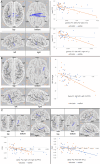Altruism Enhances Frontal Alpha Asymmetry and Reduces Sympathetic Activity: A Multimodal EEG-ECG Study With Implications for Therapeutic Interventions
- PMID: 40842172
- PMCID: PMC12370850
- DOI: 10.1002/brb3.70747
Altruism Enhances Frontal Alpha Asymmetry and Reduces Sympathetic Activity: A Multimodal EEG-ECG Study With Implications for Therapeutic Interventions
Abstract
Introduction: This study aimed to investigate neurophysiological differences between altruistic and selfish behaviors by simultaneously measuring electroencephalography (EEG) and electrocardiography (ECG). Specifically, we hypothesized that altruistic behavior would be associated with distinct patterns of cortical activity and autonomic responses.
Methods: Thirty-one healthy participants (17 females; mean age: 20.00 ± 1.18 years) completed crafting tasks in a counterbalanced order under altruistic and selfish conditions. We measured and analyzed frontal alpha asymmetry (FAA) scores, cardiac sympathetic index (CSI), and cardiac vagal index (CVI). Additionally, we used eLORETA (exact-low resolution electromagnetic tomography) to examine current source density and functional connectivity patterns across brain regions.
Results: The altruistic condition exhibited significantly higher FAA scores (p = 0.031, r = 0.45) and lower CSI (p = 0.048, Cohen's d = 0.37) compared to the selfish condition. Notably, novel correlations were observed between neurophysiological measures and specific brain regions. Specifically, FAA scores were associated with gamma activity in the anterior cingulate cortex during the altruistic condition (p = 0.071) and with precuneus activity during selfish behavior (p = 0.029). Additionally, distinct functional connectivity patterns were associated with autonomic activity in the altruistic condition. Parasympathetic activity negatively correlated with temporal-gamma connectivity (p = 0.002), and heart rate change negatively correlated with temporal-prefrontal theta connectivity (p = 0.048).
Conclusions: Our findings reveal the intricate relationship between cortical activity, functional connectivity, and autonomic responses during altruistic versus selfish behaviors for the first time. This integrative approach sheds new light on the neural mechanisms underlying social cognition. This approach also has the potential to enhance our understanding of and ability to encourage prosocial behavior in various clinical and therapeutic settings.
Keywords: altruism; autonomic activity; electroencephalography; frontal alpha asymmetry; neurophysiology; social cognition; therapeutic interventions.
© 2025 The Author(s). Brain and Behavior published by Wiley Periodicals LLC.
Figures




Similar articles
-
Frontal Transcranial Direct Current Stimulation in Moderate to Severe Depression: Clinical and Neurophysiological Findings from a Pilot Study.Brain Sci. 2025 May 22;15(6):540. doi: 10.3390/brainsci15060540. Brain Sci. 2025. PMID: 40563711 Free PMC article.
-
Prescription of Controlled Substances: Benefits and Risks.2025 Jul 6. In: StatPearls [Internet]. Treasure Island (FL): StatPearls Publishing; 2025 Jan–. 2025 Jul 6. In: StatPearls [Internet]. Treasure Island (FL): StatPearls Publishing; 2025 Jan–. PMID: 30726003 Free Books & Documents.
-
Rein tension and heart rate variability in horses: an experiment on experience.J Anim Sci. 2025 Jan 4;103:skaf146. doi: 10.1093/jas/skaf146. J Anim Sci. 2025. PMID: 40331242
-
The Impact on Autonomic Nervous System Activity during and Following Exercise in Adults: A Meta-Regression Study and Trial Sequential Analysis.Medicina (Kaunas). 2024 Jul 28;60(8):1223. doi: 10.3390/medicina60081223. Medicina (Kaunas). 2024. PMID: 39202504 Free PMC article.
-
Systemic pharmacological treatments for chronic plaque psoriasis: a network meta-analysis.Cochrane Database Syst Rev. 2021 Apr 19;4(4):CD011535. doi: 10.1002/14651858.CD011535.pub4. Cochrane Database Syst Rev. 2021. Update in: Cochrane Database Syst Rev. 2022 May 23;5:CD011535. doi: 10.1002/14651858.CD011535.pub5. PMID: 33871055 Free PMC article. Updated.
References
-
- American Psychiatric Association . (2018). “APA Dictionary of Psychology.” https://dictionary.apa.org/altruism.
MeSH terms
LinkOut - more resources
Full Text Sources
Miscellaneous

